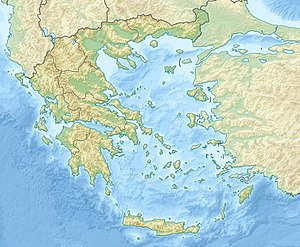| Grave Circle A | |
|---|---|
| Native name Ταφικός περίβολος A' (Greek) | |
 Grave Circle A (left) and the main entrance of the citadel (right) | |
| Location | Mycenae |
| Coordinates | 37°43′49″N 22°45′22″E / 37.73028°N 22.75611°E |
| Area | Argolis, Greece |
| Formed | 16th century BC |
| Built for | Resting place of the Mycenaean ruling families |
Grave Circle A is a 16th-century BC royal cemetery situated to the south of the Lion Gate, the main entrance of the Bronze Age citadel of Mycenae in southern Greece.[1] This burial complex was initially constructed outside the walls of Mycenae and ultimately enclosed in the acropolis when the fortification was extended during the 13th century BC.[1] Grave Circle A and Grave Circle B, the latter found outside the walls of Mycenae, represents one of the significant characteristics of the early phase of the Mycenaean civilization.[2]
The site circle has a diameter of 27.5 m (90 ft) and contains six shaft graves. The largest of the shaft graves measures about 6.5 m (21 ft 4 in) in length and about 4.1 m (13 ft 5 in) in width. A total of nineteen bodies of men, women, and children buried here, with two to five bodies per shaft.[3] It has been suggested that a mound was constructed over each grave, and funeral stelae were erected. Among the funerary gifts found were a series of gold death masks, full sets of weapons, ornate staffs, gold jewelry, as well as gold and silver cups. The funerary gifts found here are more precious than that of those at Grave Circle B. It has been estimated that Circle A contained about 15 kilos of gold in total (not all of high purity); a considerable quantity, but a good deal less than in just the inner coffin of Tutankhamun.[4]
The site was excavated by the archaeologist Heinrich Schliemann and Panagiotis Stamatakis in 1876–77, following the descriptions of Homer and Pausanias. One of the five gold death masks he unearthed became known as "The Death Mask of Agamemnon", ruler of Mycenae, of Greek mythology.[5] However, it has been proven that the burials are dated approximately three centuries earlier before Agamemnon is supposed to have lived.
The valuable funerary gifts in the graves suggest that powerful rulers were buried in this site. Although Agamemnon was supposed to have lived centuries later, these graves might have belonged to the former ruling dynasty of Mycenae – in Greek mythology, the Perseids.[6] In later Greek mythology, Mycenae had a period where two kings ruled, and archeologists have suggested that these dual graves may correspond to both kings.[7]
- ^ a b "The Bronze Age on the Greek Mainland: Mycenaean Greece – Mycenae". Athens: Foundation of the Hellenic World. 1999–2000. Retrieved 9 March 2011.
- ^ Komita 1982, p. 60.
- ^ Pedley 2012, p. 86.
- ^ Hood 1978, p. 23.
- ^ Morris & Powell 2010, p. 60.
- ^ Castleden 2005, p. 42.
- ^ Neer 2012.
